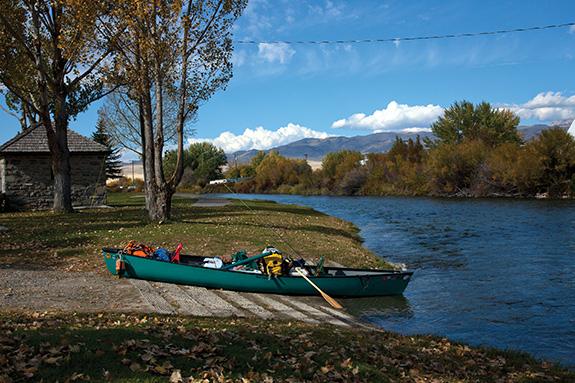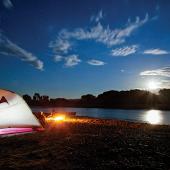A Canoe & You
Float the summer away.
The rock caught both of us by surprise. In disbelief, my paddling partner Bill and I felt the boat hesitate for an instant, balanced on the unseen boulder like a see-saw on a fulcrum, and then with a whoosh, the upstream gunwale dipped under and into the briny deep we went. I thrashed around for a moment and then slowly found my footing. The water was all of ten inches deep.
Turns out we had violated the second rule of hitting rocks: lean over the downstream gunwale, instead of away. The first rule? Avoid rocks.
Choose a Spot, Dip a Paddle
In Montana, there’s plenty of canoeing fun to go around. The state has countless rivers and lakes that are perfect for an overnight, from the aqua-blue depths of Yellowstone Lake to the chalk-white cliffs on the Missouri. And for those that need a shot of adrenaline to leaven their pastoral paddling, on most trips there’s always the outside chance of going overboard. And with thousands of miles of rivers to choose from, most Montana canoe trips are secluded affairs. The price of solitude? A canoe and some basic safety and camping gear.
What You Need
One of the great things about canoes—and one of the bad things about canoes—is that there are so many varieties to choose from. As is generally true elsewhere, the more you pay, the more you get. That doesn’t mean you have to buy your boat new, however. I bought my 17-foot Wenonah used but not abused for a few hundred dollars, well below what it would have cost off the shelf. And it included knee braces, extra seats, and a shoulder yoke for portages.
As a general rule, longer boats—17- and 18-foot tandem canoes—are easier to paddle and hold more gear. Short, wide boats are more stable but less inclined to track well. Most manufactured canoes are made of fiberglass, fiberglass/kevlar composites, or heavy but nearly bulletproof plastic. Aluminum canoes, the kind some of us grew up with in Boy Scout camp, are still around, and if you can find one used, they’re tough as nails and usually quite cheap.
You’ll also need a PFD (Personal Floatation Device, or life vest). Life vests designed for canoeing and kayaking are lightweight and have wide arm-holes for full range of motion. Paddles round out your gear, and here it pays to shop around. They range from inexpensive aluminum and wooden jobs to high-tech bent-shaft paddles with balanced graphite shafts. The choice is up to you, but you’ll need at least three of them, one for the stern-man, one for the bow-man, and a spare. A throw rope for water rescues and some type of basic repair kit are good ideas, as well.
On dry land, you’ll want camping gear that allows you to fully relax after a hard (or not so hard) day of floating, paddling, and fishing. There’s an endless variety of canoe-camping gear these days, so shop with discretion. A good place to start is with basic backpacking gear, which is light, compact, and easy to stow in the various dry bags you’ll need if you don’t own them already. My gear includes a lightweight tent, ground cloth, gas stove, synthetic sleeping bag in a waterproof stuff sack (which is stuffed inside a dry bag, just to be sure), camp shoes (nothing is quite as luxurious as slipping into a pair of dry sneakers after a day of paddling in wet feet), rain gear, a change of clothes, and basic toiletries.
One of the delicious luxuries of canoe tripping, however, is that it doesn’t demand the meticulous attention to weight that backpacking requires. Therefore, most of the trips I’ve been on have been marked by personal indulgences in one form or another. I wouldn’t float anywhere without my Therm-a-rest camp seat, nor would I consider leaving on a trip without a small solar shower stuffed into my dry bag.

Where to Go
One of the dangers of writing about canoeing in Montana is that there are so many great floats; mentioning only a couple runs the risk of outraging loyalists of others who feel they’ve been given short shrift. With that in mind, I’ll stick to a couple classics, one close to home and one further afield, and let you discover more on your own.
The Jefferson River. This is one of my favorite trips. The stretch from Silver Star to Cardwell is a great overnighter with lots of wildlife; but on the downside, fishing is slow and flows can lower dramatically toward the end of summer. Watch for diversion dams below Parson’s Bridge and the Parrot Castle access site.
The Lower Yellowstone River. By mid-summer, water levels are at a manageable flow for novice and intermediate canoeists. Start at Big Timber and float as far as you'd like, enjoying wildlife-rich, big-ranch country, along with easy shuttles along I-90. Bring a fishing rod and binoculars.










